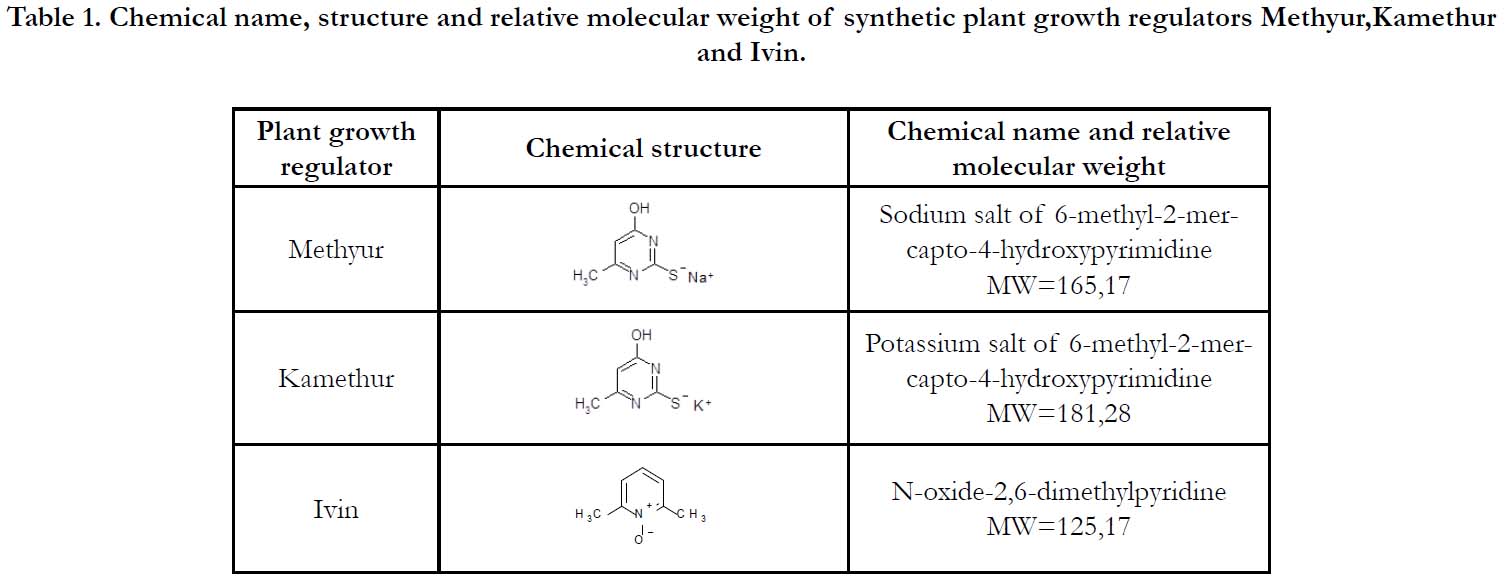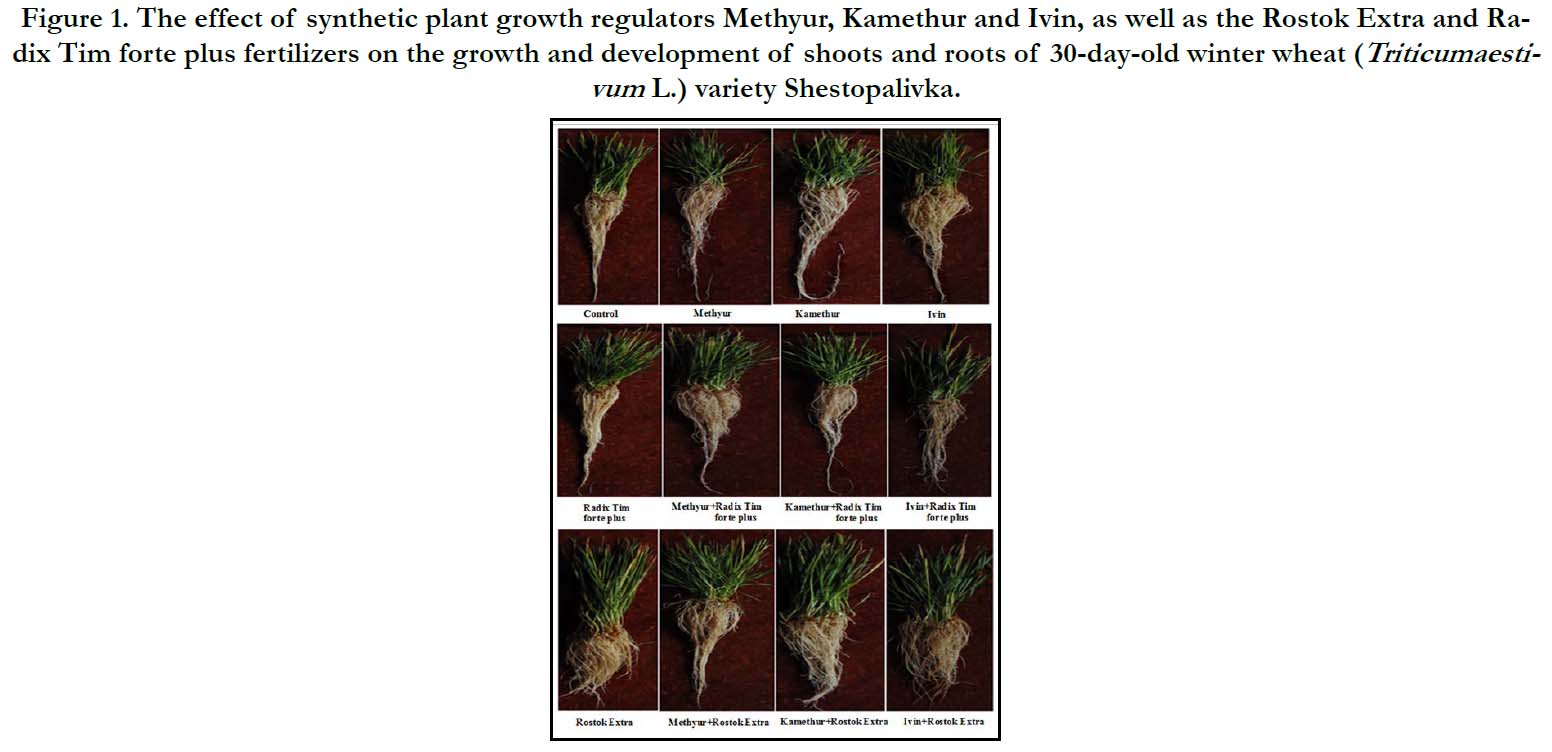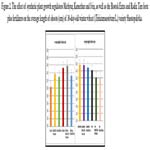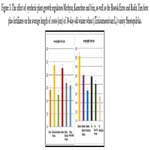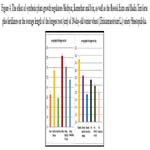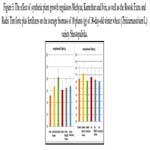Use Of Synthetic Plant Growth Regulators In Combination With Fertilizers to Improve Wheat Growth
Tsygankova V.A.1*, Andreev A.M.1, Andrusevich Ya.V.1, Pilyo S.G.1, Klyuchko S.V.1, Brovarets V.S.1
1 Department for Chemistry of Bioactive Nitrogen-Containing Heterocyclic Compounds, V.P. Kukhar Institute of Bioorganic Chemistry and Petrochemistry, National Academy of Sciences of Ukraine, 1, Academician Kukhar str., 02094, Kyiv, Ukraine.
*Corresponding Author
Tsygankova V.A,
Department for Chemistry of Bioactive Nitrogen-Containing Heterocyclic Compounds, V.P. Kukhar Institute of Bioorganic Chemistry and Petrochemistry, National Academy of
Sciences of Ukraine, 1, Academician Kukhar str., 02094, Kyiv, Ukraine.
E-mail: vTsygankova@ukr.net
Recieved: March 29, 2023; Accepted: April 06, 2023; Published: April 27, 2023
Citation: Tsygankova V.A., Andreev A.M., Andrusevich Ya.V., Pilyo S.G., Klyuchko S.V., Brovarets V.S. Use Of Synthetic Plant Growth Regulators In Combination With Fertilizers
to Improve Wheat Growth. Int J Med Biotechnol Genetics. 2023;S1:02:002:9-14.
Copyright: Tsygankova V.A© 2022. This is an open-access article distributed under the terms of the Creative Commons Attribution License, which permits unrestricted use, distribution and reproduction in any medium, provided the original author and source are credited..
Abstract
An urgent task of modern agricultural biotechnology is the development of new environmentally friendly plant growth regulators
to improve the growth and increase the yield of the important cereal crop wheat (Triticum aestivum L.). In our experiments,
the effect of new synthetic plant growth regulators Methyur, Kamethur and Ivin, as well as Rostok Extra and Radix Tim forte
plus fertilizers, applied separately or in combination, on the growth parameters of 30-day-old winter wheat (Triticum aestivum L.) variety Shestopalivka was studied.The highest values of growth parameters of wheat plants were obtained with the separate
use of each of the synthetic plant growth regulators Methyur, Kamethur and Ivin, as well as fertilizer Radix Tim forte
plus, and with the use of each of the synthetic plant growth regulators in a complex with fertilizers: Methyur with Rostok
extra, Kamethur with Rostok extra, Methyur with Radix Tim forte plus, Kamethur with Radix Tim forte plus, Ivin with Radix
Tim forte plus. To improve the vegetative growth of winter wheat (Triticum aestivum L.) variety Shestopalivka, it is suggested
to use each of the synthetic plant growth regulators Methyur, Kamethur and Ivin separately or in combination with Rostok
Extra and Radix Tim forte plus fertilizers.
2.Introduction
3.Materials and Methods
4.Results
5.Discussion
6.Conclusion
7.References
Keywords
Wheat (Triticum aestivum L.); Synthetic Plant Growth Regulators; Ivin; Methyur; Kamethur; Fertilizers; Rostok Extra; Radix Tim Forte Plus.
Introduction
An urgent problem of the modern agricultural biotechnology is
the development of new efficient and environmentally friendly
technologies for growing wheat - the most important grain crop
for obtaining organic agricultural products and reducing environmental
pollution [1-4].
Hans Braun, Head of the Global Wheat Program at the International
Maize and Wheat Improvement Center (CIMMYT), predicts
a coming food crisis, as world population rises to 9.2 billion
people by 2050, especially in developing countries, Africa and
South Asia [5]. He talks about the need for a “new green revolution”
because he says that population growth is likely to outstrip wheat
yields and calls for increased investment in wheat and other cereal
crops to keep up with future demand.
Global climate change and abiotic and biotic stresses are key
negative factors affecting agricultural crop production worldwide
[6-9]. Currently, in order to solve this urgent problem, natural
or synthetic plant growth regulators and fertilizers are used to
improve the life processes of agricultural crops, namely for better
assimilation of nutrients, improvement of plant growth and
photosynthetic efficiency, which contributes to increased yield
and plant's resistance to abiotic and biotic stress factors, and also
allows the plant to make the most of its natural potential in the
growth process [10-23]. The use of natural or synthetic plant
growth regulators and fertilizers is one of the promising areas of
the agricultural biotechnology, which will contribute to improving
the quality of products, increasing the yield and plant stress tolerance,
and economic efficiency of growing wheat crops [10-17,
20-23].The use of ecologically safe natural or synthetic growth
regulators and fertilizers will help reduce the use of pesticides
and fungicides that are toxic to human and animal health, improve
the balance of natural ecosystems and phytosanitary condition of the soil, and improve the ecological condition of the entire agricultural
system [24-29].
In modern conditions of growing shortage of food products and
the need to increase the productivity of wheat crops against the
background of adverse environmental factors, climate change,
systemic depletion of soils, high prices for fertilizers and their
shortage, negative balance of macro- and microelements, the creation
of new multifunctional plant growth regulators is a very urgent
task. Achievements in the field of preservation and improvement
of the environment and sustainable development lie in the
possibility of developing new plant growth regulators based on
synthetic low molecular weight heterocyclic compounds, in particular,
pyridine and pyrimidine derivatives.Today, pyridine and pyrimidine
derivatives are widely used in agriculture as plant growth
regulators, herbicides and fungicides [30-39].
The new plant growth regulators based on synthetic compounds,
derivatives of N-oxide-2,6-dimethylpyridine (Ivin) and 6-methyl-
2-mercapto-4-hydroxypyrimidine sodium and potassium salts
(Methyur and Kamethur) were developed at the V.P. Kukhar Institute
of Bioorganic Chemistry and Petrochemistry, of the NAS of
Ukraine.These plant growth regulators have already been tested
in laboratory and field conditions and have shown high efficiency
in improving the growth of various agricultural and ornamental
crops, increasing their productivity and adaptive properties
to stress factors of abiotic and biotic nature [17-37, 40-45]. The
advantage of their practical application is the wide specificity of
the action on various agricultural crops when used in low environmentally
friendly concentrations.This advantage makes it possible
to reduce the negative impact of ecologically toxic pesticides and
fungicides created on the basis of chemical compounds of other
classes, the excess amount of which accumulates in the soil and
in agricultural plants, which are products of human and animal
consumption [24-29, 46].
The purpose of this work is to study the impact of new synthetic
plant growth regulators based on pyridine and pyrimidine
derivatives and their complexes with fertilizers on the growth and
development of important cereal crop wheat (Triticum aestivum L.).
Materials and Methods
In our work, we investigated the regulatory effect of synthetic
plant growth regulators based on pyridine and pyrimidine derivatives:
Ivin (N-oxide-2,6-dimethylpyridine), Methyur (sodium salt
of 6-methyl-2-mercapto-4-hydroxypyrimidine) and Kamethur
(potassium salt of 6-methyl-2-mercapto-4-hydroxypyrimidine),
which were used alone or in combination with fertilizers Rostok
Extra and Radix Tim forte plus on the growth and development
of winter wheat (Triticum aestivum L.) variety Shestopalivka grown
in laboratory conditions.
Plant growth regulators Methyur, Kamethur and Ivin were synthesized
at the Department for Chemistry of Bioactive Nitrogen-
Containing Heterocyclic Compounds, V.P. Kukhar Institute of
Bioorganic Chemistry and Petrochemistry of the National Academy
of Sciences of Ukraine (Table 1).
Fertilizer Rostok Extra produced by the LLc “Ukrainian Agrarian
Resource” company is complex, liquid, chelated fertilizer intended
for pre-sowing seed treatment, foliar fertilization and drip irrigation.
It is a universal fertilizer that improves seed germination,
plant resistance to stress factors, increases yield and improves the
quality of products of most agricultural, vegetable, fruit and berry
crops [47, 48]. Its chemical composition is as follows (g/l): Nitrogen
(N) - 100, Phosphorus (P2O5) - 300, Potassium (K2O) - 100,
Magnesium (MgO) - 22, Sulfur (SO3) - 55, trace elements (Mn
- 10, B - 2, Zn - 25, Cu - 5), amino acids, humic substances [49].
Fertilizer Radix Tim forte plus produced by the “Forcrop” Company
(Spain) is practically used as a root growth stimulator of
fruit, berry, decorative and vegetable crops grown in open and
closed soil, which provides the root system with activators and
minerals for its proper development and rejuvenation, and also
protects of the root system from stress and prevents the roots
from fungal attacks that can harm its maximum development
[50, 51]. It is used both for better rooting after transplanting and
throughout the growing season of the plant to maintain the root
system in a healthy and functional state. Its chemical composition
is as follows (W/V): Nitrogen (N) - 3.7%, Potassium (K2O)
- 4.1% Phosphorus (P2O5) - 11.3%, free amino acids - 5.7%, trace
elements (Zn, Mn, B, Mo and Fe) [50, 51].
To study the effect of synthetic plant growth regulators Methyur,
Kamethur and Ivin, as well as fertilizers Rostok Extra and Radix
Tim forte plus on the wheat growth and development, wheat
seeds were treated with fertilizer Rostok Extra at a concentration of 100 ml per 1 liter of distilled water or fertilize rRadix Tim forte
plus at a concentration of 50 ml per 1 liter of distilled water, or
each of the synthetic plant growth regulators: Methyur, or Kamethur,
or Ivin at a concentration of 10-7M per l liter of distilled
water, or a combination of each of the synthetic plant growth
regulators Methyur, or Kamethur, or Ivin with the fertilizers Rostok
Extra and Radix Tim forte plus used in the above mentioned
concentrations. The treated seeds were placed in a thermostat for
germination in the dark at a temperature 22-23°С for 48 hours.
After this procedure, germinated wheat seeds were placed in a
climatic chamber, where wheat seedlings were grown in a light/
dark regime of 16/8 hours, at a temperature of 22-23 °C, a light
intensity of 3000 lux and an air humidity of 60-80 %. The growth
parameters of wheat plants (average length of the shoots and
roots (cm), average length of the longest root (cm), and average
biomass of 10 plants (g)) were measured on the 30th day of growing
wheat plants according to the methodology [52].
Statistical processing of the data of the experiments performed
in three replications was carried out according to the Student’s-t
variance test with a significance level of P≤0.05; the values are
average ± SD [53].
Results and Discussion
The main factor in increasing the quantity and quality of agricultural
products is the rational use of each hectare of arable land,
first of all due to a scientifically based fertilization system. According
to the FAO, Western Europe and the USA get a third of
their crops due to the use of fertilizers [54]. The implementation
of intensive technologies for the introduction of fertilizers into
agricultural practice will allow obtaining high yields with good
product quality in almost all climatic zones [13, 18-20, 23, 47, 51,
54-56].
Today, there is a great demand for new effective natural or synthetic
plant growth regulators that show biological activity related
to natural phytohormones to improve the growth and development
of the important cereal crop - wheat and increase its yield
[10 - 12, 14 - 17, 21, 22].
In our previous studies, conducted in laboratory and field conditions,
the stimulating effect of the new synthetic plant growth
regulators Ivin (N-oxide-2,6-dimethylpyridine), Methyur (sodium
salt of 6-methyl-2-mercapto-4-hydroxypyrimidine) and Kamethur
(potassium salt of 6-methyl-2-mercapto-4-hydroxypyrimidine) on
improving the growth and development of grain, industrial and
ornamental crops (corn, barley, oats, sorghum, miscanthus, rose),
increasing their productivity as well as their adaptation to abiotic
stress factors was shown [17, 37, 40 – 45]. Thus, a very promising
issue is the study of the effect of synthetic plant growth regulators
Methyur, Kamethur and Ivin used alone or in combination
with fertilizers Rostok Extra and Radix Tim forte plus, on the
growth and development of an important cereal crop – wheat. It
is this issue that was studied in the present work.
The results of our experiments have shown that both the synthetic
plant growth regulators Methyur, Kamethur and Ivin, as well as
the Rostok Extra and Radix Tim forte plus fertilizers, which were
used separately or in combination have a positive effect on the
growth and development of shoots and roots of winter wheat
(Triticum aestivum L.) variety Shestopalivka, which was grown for 30
days under laboratory conditions (Fig. 1).
Statistical analysis of growth parameters of 30-day-old wheat
plants showed that the parameters of the average length of shoots
(cm) increased both with the separate application of fertilizers:
Radix Tim forte plus - by 34.38% and Rostok Extra - by 25.68%,
and plant growth regulators: Ivin - by 37.89%, Methyur - by 48.82
%, Kamethur – by 53.22%, as well as with complex application
of fertilizers with growth regulators: Ivin+Radix Tim forte plus
– by 18.55%, Ivin+Rostok Extra – by 15.04%, Methyur+Radix
Tim forte plus – by 53.91%, Methyur+Rostok Extra – by 34.67%,
Kamethur+Radix Tim forte plus – by 52.05%, Kamethur+Rostok
Extra – by 39.16%, respectively, compared to similar parameters
of control wheat plants (Fig. 2).
The parameters of the average length of roots (cm) increased both with the separate application of fertilizers: Radix Tim forte plus -
by 67.58% and plant growth regulators: Ivin - by 72.80%, Methyur
- by 58.84 %, Kamethur – by 153.28%, as well as with complex
application of fertilizers with growth regulators: Ivin+Radix
Tim forte plus – by 44.54%, Methyur+Radix Tim forte plus – by
18.32%, Methyur+Rostok Extra – by 12.54%, Kamethur+Radix
Tim forte plus – by 78.72%, Kamethur+Rostok Extra – by
17.27%, respectively, compared to similar parameters of control
wheat plants (Fig. 3).
The parameters of the average length of the longest root (cm)
increased both with the separate application of fertilizers: Radix
Tim forte plus - by 75.17% and plant growth regulators: Ivin -
by 73.64%, Methyur - by 120.23%, Kamethur – by 160.33%, as
well as with complex application of fertilizers with growth regulators:
Ivin+Radix Tim forte plus – by 51.20%, Ivin+Rostok Extra
– by 23.73%, Methyur+Radix Tim forte plus – by 86.70%,
Methyur+Rostok Extra – by 44.94%, Kamethur+Radix Tim forte
plus – by 91.42%, Kamethur+Rostok Extra – by 15.08%, respectively,
compared to similar parameters of control wheat plants
(Fig. 4).
The parameters of the average biomass of 10 plants (g) increased
both with the separate application of fertilizers: Radix Tim forte
plus - by 28.85% and Rostok Extra – by 57.69%, and plant growth
regulators: Ivin - by 28.85%, Methyur - by 17.31%, Kamethur
– by 23.08%, as well as with complex application of fertilizers
with growth regulators: Ivin+Radix Tim forte plus – by 21.15%,
Ivin+Rostok Extra – by 15.38%, Methyur+Radix Tim forte plus –
by 25%, Methyur+Rostok Extra – by 30.77%, Kamethur+Radix
Tim forte plus – by 38.46%, Kamethur+ Rostok Extra – by
17.31%, respectively, compared to similar parameters of control wheat plants (Fig. 5).
Thus, summarizing the obtained data, it should be noted that the
highest values of growth parameters of wheat plants were obtained
with the separate use of each of the synthetic plant growth
regulators Methyur, Kamethur and Ivin, as well as fertilizer Radix
Tim forte plus, and with the use of each of the synthetic growth
regulators in a complex with fertilizers: Methyur with Rostok extra,
Kamethur with Rostok extra, Methyur with Radix Tim forte
plus, Kamethur with Radix Tim forte plus, Ivinwith Radix Tim
forte plus.
Table 1. Chemical structure and relative molecular weight of plant growth regulators Methyur, Kamethur and Ivin.
Figure 1. The effect of plant growth regulators Methyur, Kamethur, Ivin and fertilizers Rostok Extra and Radix Tim forte plus on the growth of shoots and roots of 30-day-old winter wheat (Triticum aestivum L.) variety Shestopalivka.
Figure 2. The effect of plant growth regulators Methyur, Kamethur, Ivin and fertilizers Rostok Extra and Radix Tim forte plus on the average length of shoots (cm) of 30-day-old winter wheat (Triticum aestivum L.) variety Shestopalivka.
Figure 3. The effect of plant growth regulators Methyur, Kamethur, Ivin and fertilizers Rostok Extra and Radix Tim forte plus on the average length of roots (cm) of 30-day-old winter wheat (Triticum aestivum L.) variety Shestopalivka.
Figure 4. The effect of plant growth regulators Methyur, Kamethur, Ivin and fertilizers Rostok Extra and Radix Tim forte plus on the average length of the longest root (cm) of 30-day-old winter wheat (Triticum aestivum L.) variety Shestopalivka.
Figure 5. The effect of plant growth regulators Methyur, Kamethur, Ivin and fertilizers Rostok Extra and Radix Tim forte plus on the average biomass of 10 plants (g) of 30-day-old winter wheat (Triticum aestivum L.) variety Shestopalivka.
Conclusion
The conducted studies showed the prospects of using synthetic
plant growth regulators Methyur, Kamethur and Ivin, developed
at the V.P. Kukhar Institute of Bioorganic Chemistry and Petrochemistry,
of the NAS of Ukraine separately or in combination
with fertilizers Rostok Extra produced by the LLc“Ukrainian
Agrarian Resource Company” (Ukraine) and Radix Tim forte plus
produced by the “Forcrop” Company (Spain) for improvement
of growth and development of shoots and roots of winter wheat
(Triticum aestivum L.) variety Shestopalivka during the vegetative
stage.
References
- Shiferaw B, Smale M, Braun HJ, Duveiller E, Reynolds M, Muricho G. Crops that feed the world 10. Past successes and future challenges to the role played by wheat in global food security. Food Sec. 2013 Jun;5:291-317.
- Faltermaier A, Waters D, Becker T, Arendt E, Gastl M. Common wheat (Triticum aestivum L.) and its use as a brewing cereal–a review. J Inst Brew. 2014 Jan;120(1):1-5.
- Erenstein O, Jaleta M, Mottaleb KA, Sonder K, Donovan J, Braun HJ. Global trends in wheat production, consumption and trade. InWheat Improvement: Food Security in a Changing Climate 2022 Jun 3 (pp. 47-66). Cham: Springer International Publishing.
- Ahmed E, Sulaiman J, Mohd S. Wheat production and economics. Am J AgricBiol Sci. 2011;6(3):332-8.
- Peña-Bautista RJ, Hernandez-Espinosa N, Jones JM, Guzmán C, Braun HJ. CIMMYT series on carbohydrates, wheat, grains, and health: wheat-based foods: their global and regional importance in the food supply, nutrition, and health. Cereal Foods World. 2017 Sep 1;62(5):231-49.
- Fahad S, Bajwa AA, Nazir U, Anjum SA, Farooq A, Zohaib A, et al. Crop Production under Drought and Heat Stress: Plant Responses and Management Options. Front Plant Sci. 2017 Jun 29;8:1147. PubMed PMID: 28706531.
- Dresselhaus T, Hückelhoven R. Biotic and abiotic stress responses in crop plants. Agronomy. 2018 Nov 19;8(11):267.
- Gimenez E, Salinas M, Manzano-Agugliaro F. Worldwide research on plant defense against biotic stresses as improvement for sustainable agriculture. Sustainability. 2018 Feb 2;10(2):391.
- Anderson R, Bayer PE, Edwards D. Climate change and the need for agricultural adaptation. CurrOpin Plant Biol. 2020 Aug;56:197-202. PubMed PMID: 32057694.
- Basra A, editor. Plant growth regulators in agriculture and horticulture: their role and commercial uses. CRC press; 2000 Dec 13.
- Роnоmаrenko SP, Hrytsaenko ZM, Tsygankova VA. Increase of plant resistance to diseases, pests and stresses with new biostimulants. ActaHortic. 2013;1009:225-233.
- Rademacher W. Plant Growth Regulators: Backgrounds and Uses in Plant Production. J Plant Growth Regul. 2015 Dec;34:845-72.
- Bhardwaj D, Ansari MW, Sahoo RK, Tuteja N. Biofertilizers function as key player in sustainable agriculture by improving soil fertility, plant tolerance and crop productivity. Microb Cell Fact. 2014 May 8;13:66. PubMed PMID: 24885352.
- Calvo P, Nelson L, Kloepper JW. Agricultural uses of plant biostimulants. Plant and Soil. 2014 Oct;383:3-41.
- Tsygankova VA, Iutynska GA, Galkin AP, Blume YB. Impact of new natural biostimulants on increasing synthesis in plant cells of small regulatory si/ miRNA with high anti-nematodic activity. Int J Biol. 2014 Jan 1;6(1):48.
- Le Mire G, NguyenML, FassotteB, JardinP, VerheggenF, DelaplaceP, et al- .Implementingplantbiostimulantsandbiocontrolstrategiesintheagroecologica lmanagementofcultivated ecosystems. A review. BiotechnolAgronSocEnviron. 2016;20(S1):299-313.
- Tsygankova VA, Andrusevich YV, Blyuss KB, Shysha EN, Yemets AI, Biliavska LA, et al. Using microbial biostimulants to deliver rna interference in plants as an effective tool for biocontrol of Pathogenic Fungi, parasitic nematodes and insects. InResearch Advances in Plant Biotechnology 2020. pp. 205-319.
- Mazur V, Didur I, Myalkovsky R, Pantsyreva H, Telekalo N, Tkach O. The productivity of intensive pea varieties depending on the seeds treatment and foliar fertilizing under conditions of right-bank forest-steppe Ukraine. Ukr J Ecol. 2020;10(1):101-5.
- Lin S, Pi Y, Long D, Duan J, Zhu X, Wang X, et al. Impact of Organic and Chemical Nitrogen Fertilizers on the Crop Yield and Fertilizer Use Efficiency of Soybean–Maize Intercropping Systems. Agriculture. 2022 Sep 9;12(9):1428.
- Davydova OE, Axylenko MD, Kotenko SI, Gaevskyi AP, Kaplunenko VG. New composite preparations for improving nitrogen-phosphorus nutrition of wheat. Plant Physiol Gen. 48(5):424-432.
- Blyuss KB, Fatehi F, Tsygankova VA, Biliavska LO, Iutynska GO, Yemets AI, et al. RNAi-Based Biocontrol of Wheat Nematodes Using Natural Poly- Component Biostimulants. Front Plant Sci. 2019 Apr 17;10:483. PubMed PMID: 31057585.
- Tsygankova VA, Spivak SI, Shysha OM, Pastukhova NL, Yemets AI, Blume YB.The application of biostimulantsRegoplant and Stimpo to increase wheat resistance to salinity conditions. FaktoriEksperimentalnoiEvoluciiOrganizmiv. 2021;28:117-122.
- Lamlom SF, Irshad A, Mosa WFA. The biological and biochemical composition of wheat (Triticumaestivum) as affected by the bio and organic fertilizers. BMC Plant Biol. 2023 Feb 23;23(1):111. PubMed PMID: 36814215.
- Muri SD, van der Voet H, Boon PE, van Klaveren JD, Brüschweiler BJ. Comparison of human health risks resulting from exposure to fungicides and mycotoxins via food. Food ChemToxicol. 2009 Dec;47(12):2963-74. PubMed PMID: 19345717.
- Alewu B, Nosiri C. Pesticides and Human Health, Pesticides in the Modern World-Effects of Pesticides Exposure, M.Stoytcheva (Ed.). In Tech Open; 2011.
- Nicolopoulou-Stamati P, Maipas S, Kotampasi C, Stamatis P, Hens L. Chemical Pesticides and Human Health: The Urgent Need for a New Concept in Agriculture. Front Public Health. 2016 Jul 18;4:148. PubMed PMID: 27486573.
- Роnоmаrenko SP, Hrytsaenko ZM, Tsygankova VA, Babayants OV. Synergistic effect of bioregulators with pesticides and herbicides on improving growth, yield quality and crop resistance against pathogens and pests. Proceedings of the 43rd Annual Meeting of the Plant Growth Regulation Society of America. North Carolina, 2016. pp. 110–125.
- Goswami SK, Singh V, Chakdar H, Choudhary P. Harmful effects of fungicides- Current status. Inter J Agric Environ Biotech. 2018;1025-1033.
- Zubrod JP, Bundschuh M, Arts G, Brühl CA, Imfeld G, Knäbel A, et al. Fungicides: An Overlooked Pesticide Class? Environ Sci Technol. 2019 Apr 2;53(7):3347-3365. PubMed PMID: 30835448.
- Kawarada A, Nakayama M, Ota Ya TS. Use of pyridine derivatives as plant growth regulators and plant growth regulating agents. Patent DE2349745A1. 1973.
- Minn K, Dietrich H, Dittgen J, Feucht D, Häuser-Hahn I, Rosinger CH. Pyrimidine Derivatives and Their Use for Controlling Undesired Plant Growth. Patent USOO8445408B2. 2013 [cited 2013May 21]. Available from: https://patentimages.storage.googleapis.com/d1/52/26/d05b90090de7ff/ US8445408.pdf
- Cansev A, Gülen H, Zengin MK, Ergin S, Cansev M. Use of Pyrimidines in Stimulation of Plant Growth and Development and Enhancement of Stress Tolerance. WIPO Patent WO2014/129996A1. 2014 [cited 2014 Aug 28]. Available from:https://patents.google.com/patent/WO2014129996A1/en
- Mansfield DJ, Rieck H, Greul J, Coqueron PY, Desbordes P, Genix P, et al. Pyridine derivatives as fungicidal compounds. PatentUS7754741B2. 2010 [cited 2010 Jul13]. Available from: https://patents.google.com/patent/ US7754741
- Boussemghoune MA, Whittingham WG, Winn CL, Glithro H, Aspinall MB. Pyrimidine derivatives and their use as herbicides. Patent US20120053053 A1. 2012 [cited 2012 Mar 1]. Available from: https://patents.google.com/ patent/US20120053053
- Tsygankova V, Andrusevich Y, Shtompel O, Kopich V, Solomyanny R, Bondarenko O, et al. Phytohormone-like effect of pyrimidine derivatives on the regulation of vegetative growth of tomato.Int JBotany Stud. 2018;3(2):91-102.
- Tsygankova V, Ya A, Shtompel O, Romaniuk O, Yaikova M, Hurenko A, et al. Application of synthetic low molecular weight heterocyclic compounds derivatives of pyrimidine, pyrazole and oxazole in agricultural biotechnology as a new plant growth regulating substances. Int J Med Biotechnol Genetics. 2017 Mar 22;S2(002):10-32.
- Tsygankova VA, Brovarets VS, Yemets AI, Blume YB. Prospects for the development of plant growth regulators based on azoles, azines and their condensed derivatives in Ukraine, Synthesis and bioactivity of functionalized nitrogen-containing heterocycles, A.I. Vovk (Ed.). Kyiv: Interservice; 2021. pp. 246-285.
- Tsygankova VA, Voloshchuk IV, AndrusevichYa V, Kopich VM, Pilyo SG, Klyuchko SV, et al. Pyrimidine Derivatives As Analogues Of Plant Hormones For Intensification Of Wheat Growth During The Vegetation Period. J Adv Biol.2022;15:1-10.
- Tsygankova VA, Andrusevich YV, Shtompel OI, Solomyanny RM, Hurenko AO, Frasinyuk MS, et al. New Auxin and Cytokinin Related Compounds Based on Synthetic Low Molecular Weight Heterocycles. In Auxins, Cytokinins and Gibberellins Signaling in Plants 2022 Aug 19. pp. 353-377. Cham: Springer International Publishing.
- Tsygankova VA, Andrysevich YV, Shtompel OI, Kopich VM, Kluchko SV, Brovaretz VS. Using Pyrimidine Derivatives - Sodium Salt of Methyur and Potassium Salt of Methyur, to Intensify the Growth of Corn. Patent of Ukraine 130921. 2018 [cited 2018 Dec 12]. Available from: scholar. google.com.ua/citations?view_op=view_citation&hl=uk&user=hDZtS NwAAAAJ&cstart=100&pagesize=100&sortby=pubdate&citation_for_ view=hDZtSNwAAAAJ:P-MJmu9ZMwQC
- Tsygankova V, Voloshchuk I, Andrusevich Y, Shtompel O, Kopich V, Klyuchko S, et al. The influence of the derivative of pirimidine – Methyur on the yield of the maize, beet and oats plants. The 8th International scientific and practical conference “Topical issues of the development of modern science”. Publishing House “Accent”. Sofia, Bulgaria; 2020. pp. 514-523.
- Tsygankova VA, Voloshchuk IV, Andrusevich YV, Shtompel OI, Kopich VM, Klyuchko SV, et al. Using Pyrimidine and Pyridine Derivatives for Regulation of Growth and Development of Barley Plants. Proceedings of the Innovative Development of Science and Education; ISGT Publishing House: Athens, Greece. 2020:52-68.
- Tsygankova V, Voloshchuk I, Klyuchko S, Pilyo S, Brovarets V, Kovalenko O. The effect of pyrimidine and pyridine derivatives on the growth and productivity of Sorghum. Int. J. Bot. Stud. 2022;7:19-31.
- Pidlisnyuk V, Mamirova A, Newton RA, Stefanovska T, Zhukov O, Tsygankova V, et al. The Role of Plant Growth Regulators in Miscanthus× giganteus Growth on Trace Elements-Contaminated Soils. Agronomy. 2022 Dec;12(12):2999.
- Tsygankova V, Oliynyk O, Kvasko OY, Pilyo S, Klyuchko S. Brovarets VS. Effect of Plant Growth Regulators Ivin, Methyur and Kamethur on the Organo-Genesis of Miniature Rose (Rosa mini L.) In Vitro. Int J Med Biotechnol Genet S. 2022 Oct 31;1:1-8.
- Vasetska O, Zhminko P, Prodanchuk M, Galkin A, Tsygankova V. Perspective for using 2, 6-dimethylpyridine-N-oxide to reduce the toxic effect of xenobiotics in mammals. JAdvPharmEducRes. 2022;12(1):21-29.
- Yamkovy V, Yunyk A, Plotnikov V. "ROSTOK" - modern foliar microfertilizers for agricultural crops. J "AgroElita". 2015.
- Repka DA, Potapov EA, Beltyukov LP, Kuvshinova EK. Effectiveness of microbiological preparations, growth stimulants and fertilizers in winter wheat crops on ordinary chernozem. InIOP Conference Series: Earth and Environmental Science. 2021 Feb 1;659:012068.
- E-source:https://uarostok.ua/assortment-of-products/
- Research and innovation for crop nutrition. SUSTAINABLE AGRO SOLUTIONS FORCROP CATALOGUE. 2021.
- E-source:https://www.sas-agri.com/ru/produktsiia/radix-tim-forte/
- Voytsehovska OV, Kapustyan AV, Kosik OI, Musienko MM, Olkhovich OP, Panyuta OO, et al. Plant Physiology: Praktykum, ed. Parshikova TV–Lutsk: Teren. 2010. 420 p.
- BangH, Zhou XK, vanEpps HL, MazumdarM.StatisticalMethodsinMolecularBiology. Series:Methods in molecular biology. NewYork:Humana press. 2010;13(620):636.
- Roy RN, Finck A, Blair GJ, Tandon HL. Plant nutrition for food security. A guide for integrated nutrient management. FAO Fertilizer and Plant Nutrition Bulletin. 2006;16(368).
- Yeb B, Anbese Z.Response of Sorghum (Sorghum bicolor (L.) Moench) Varieties to Blend NPSB Fertilizer Rates under Irrigation at DasenechWoreda, South Omo Zone, Southern Ethiopia. Int J Plant Sci Agric. 2022;5(2):180- 185.
- Yeb B, Magaze M.Yield Response of Common Beans (Phaseolus vulgaris L.) to the Rate of NPS and Bio-Fertilizer Inoculation at Boloso Bombe WoredaWolaita Zone, South Ethiopia. Int J Plant Sci Agric. 2022;5(1):173- 179.

